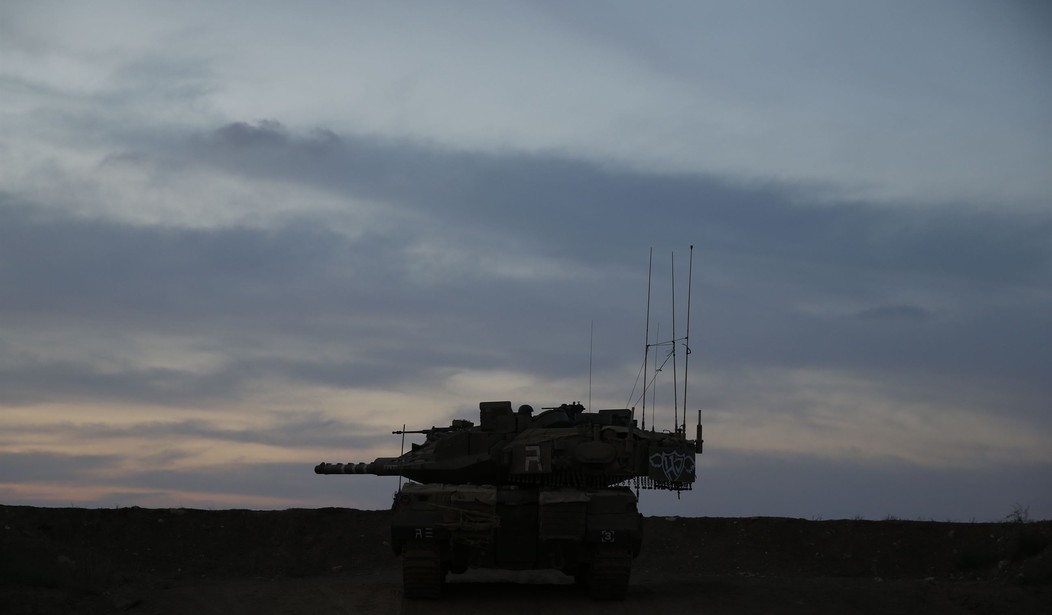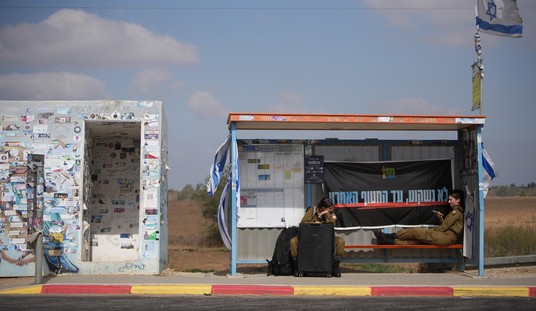Israel has surrounded Gaza City, split the strip in two, and is working methodically to eliminate all traces of Hamas from the area. They still have to eradicate the terror group to the south, but that will take time. Israeli Prime Minister Benjamin Netanyahu has warned his fellow citizens many times that this war will be long and difficult. Israelis appear to know that already, with support across the board for military action.
This is urban warfare. It’s counterinsurgency—all of which are time-consuming and resource-heavy operations. It could take years, which Netanyahu has acknowledged with his new post-Gaza plan, long after Hamas has been eliminated or irreparably degraded. The IDF will remain in the strip to handle all security matters, a position that the Biden administration is not taking too well (via WSJ):
Top Israeli officials said they intend to retain security control of Gaza for an indefinite period to prevent new militant groups forming once Israel finishes its war with Hamas, but said they have little interest in administering Gaza the way the U.S. sought to govern Iraq two decades ago.
Israeli Foreign Minister Eli Cohen, in his first interview with a foreign media outlet since the start of the war on Oct. 7, said Israel has no desire to impose a civilian administration on Gaza. Once Hamas is toppled, Israel is looking at turning over responsibility for governing the territory to an international coalition, including the U.S., the European Union and Muslim majority countries, or to local political leaders in Gaza, he said.
“We don’t want to govern Gaza. We don’t want to run their lives. We just want to protect our people,” Cohen said.
That may include keeping soldiers in Gaza if Israel deems it necessary, along with tight controls on what goes in and out. “We will need to verify that weapons will not enter Gaza from any border,” including from Egypt, “and we’ll retain our right to work against any terrorists who want to build bases there,” he said.
Israeli Prime Minister Benjamin Netanyahu expressed the same sentiment. “I think Israel for an indefinite period will have the overall security responsibility, because we’ve seen what happens when we don’t have it,” Netanyahu said, in an interview with ABC News on Monday evening.
Recommended
Who governs Gaza is another debate that no one wants to have. The unified government in Israel isn’t at all open to a return of the Palestinian Authority. The Journal added that at this time, no Arab governments or even the United Nations has the stomach to quarterback a temporary civilian administration once Hamas is driven out. The structures that hid Hamas command posts and tunnel entrances, which the IDF has destroyed, must be rebuilt by someone. In the meantime, the war to wipe out the terror group continues.
There are an estimated 40,000 Hamas terrorists in the strip alone, hiding in tunnels and shielded by two million civilians on the surface. They’ve shot the ones who’ve tried to flee to safety. The good news is that with Gaza split in two, resupply from Iran is virtually impossible. There are also another 15,000 armed terrorists with Palestinian Islamic Jihad. Even if the actual figures are one-third or half of the estimates, there are still thousands of terrorists who will be able to blend in with the civilian population.
In the tunnels, it's a nightmare. While dogs and foam bombs can be effective, the logistics of navigating the 300 miles of underground tunnels is going to be a daunting task. Don’t be surprised if Israel simply bombs and buries as many as they can, trapping Hamas fighters below to die a slow death. There’s only so much fuel stockpiled to keep the generators running to supply those with oxygen below.
Being that the tunnel system, dubbed the Gaza Metro, is connected to every city in the strip, it’s likely that a good portion of the terrorists, knowing Gaza City was about to be encircled, were able to traverse south underground. Here’s more on the tunnels from the Modern War Institute (via Modern War Institute):
The Israel Defense Forces (IDF) are very aware of the presence of Hamas tunnels in Gaza. They often refer to the group’s tunnel systems as the “metro.” The destruction of these tunnel complexes was one of the objectives of previous ground campaigns into Gaza, in 2008 and 2014. In total, there were believed to be over three hundred miles of tunnels in 2021, when Israel claimed to have destroyed sixty miles of tunnels during an eleven-day bombing campaign. Even if those tunnels have not been rebuilt or replaced, that means that it is likely that there remain hundreds of miles of intricate, complex, and deep tunnel infrastructure in Gaza. It is a veritable city underneath the cities on Gaza’s surface.
In the event of a ground campaign launched by Israel, Hamas would use its tunnels both defensively and offensively. The way it employed these spaces against the IDF during Israel’s 2014 Operation Protective Edge offers clues about what to expect in the days and weeks ahead.
Defensively, Hamas will use tunnels to escape IDF observation and attack. Any Hamas military capability that survives Israel’s current air campaign will mostly be deep underground. Hamas will have already placed its leadership, fighters, headquarters, communication, weapons, and supplies like water, food, ammunition in its tunnel complexes to prepare for the ground assault by Israeli forces. The tunnels will allow fighters to move between a series of fighting positions safely and freely under massive buildings, even after the IDF drop thousand-pound bombs on them. Hamas tunnels often have generator power, air ventilation, water pipes, and stockpiles of food that will allow the group’s fighters to better withstand the most basic challenges, like normal exhaustion, that result from urban siege and isolation. Hamas leaders and fighters will use the tunnels to remain mobile to escape entire sections of the combat area when they feel they are about to be decisively attacked or surrounded. Importantly, Hamas has also dug a large portion of its tunnels under, and connected to, civilian sites like school, hospitals, and mosques in dense urban areas. Among other reasons for doing so, this is part of its defensive lawfare strategy.
Offensively, Hamas tunnels allow the group’s forces to conduct protected and surprise attacks. They will use the tunnels to infiltrate behind IDF positions to surprise Israeli forces that might not be as well prepared or equipped for combat as those spearheading the campaign, like those in logistical areas. Interconnected tunnels under urban areas will allow Hamas to move quickly between prepared attack positions with caches of sniper rifles, antitank munitions, rifle-propelled grenades, and other weapons and ammunition. Tunnels will be the vital element of Hamas’s guerrilla warfare strategy. Its fighters will form small hunter-killer teams that move underground, pop up, strike, and pop quickly back into a tunnel. Hamas also uses the tunnels to hide and move rockets. These rockets can be remotely detonated or transported to hidden launch sites at the last minute. Hamas will also have many tunnels rigged with hundreds of pounds of explosive to function as tunnel bombs under main roads and buildings that the IDF might be lured into.
Entering tunnels presents unique tactical challenges, many of which cannot be addressed without specialized equipment. In some cases, it can be impossible to breathe without oxygen tanks in tunnels, depending on their depth and air ventilation. It can also be impossible simply to see. Most military night-vision goggles rely on some ambient light and cannot function when it is entirely absent. Any military navigation and communication equipment that relies on satellite or line-of-sight signals will not work underground. A weapon fired in compact spaces of tunnels, even a rifle, can produce a concussive effect that can physically harm the firer. A single defender can hold a narrow tunnel against a much superior force.
Of course, not all military tunnels and bunkers are the same. I have seen firsthand the wide variety, having been in North Korean invasion tunnels discovered in South Korea, Iraqi military bunkers, defensive bunkers and tunnels in Nagorno-Karabakh, and Hezbollah tunnels along the Israeli-Lebanese border. Two features typical of Hamas tunnels are important to note. First, Hamas tunnels are almost all very narrow, largely because of the prefabricated concrete sides and tops Hamas favors to build them. The average Hamas tunnel is just two meters high and a meter wide, making entering, moving through, fighting in them extremely hard. Second, because of Israel’s advancements tunnel detection and destruction, Hamas has dug its tunnels deeper and deeper. In 2020, Israel found a Hamas tunnel that descended 230 feet below the surface, the deepest found up to that point.
[…]
The IDF has the capability to find, recover hostages from, clear, neutralize, and destroy tunnels. There are specialized units like the IDF Combat Engineering Corps’s Yahalom Unit, an elite commando unit whose soldiers specializes in finding, clearing, and destroying tunnels. The large force includes subordinate units like Sayfan, which trains to handle the threat of unconventional weapons, Samur, which specializes in entering, clearing, and destroying tunnels. The Yahalom is one of the largest units in the world that trains, mans, equips, experiments, and develops new ways to deal with underground warfare. The IDF’s canine unit, Oketz, has dogs trained for operating underground. And the IDF, police, and intelligence services all have special units—like Sayeret Matkal, the Yamam, and others—who share best practices for dealing with terrorists and combatants underground.
The Yahalom and other IDF units also have special equipment specifically developed for tunnels. Tunnel reconnaissance units, for example, use ground and aerial sensors, ground-penetrating radar, drilling equipment, and other systems to find tunnels. There are radios and navigation technologies that to work underground, night-vision goggles that use thermal and other technologies to see in complete darkness, and a suite of remote or wire-controlled flying or crawling robots that can look into and map tunnels without risking soldiers. The IDF also uses virtual reality training simulators that allow soldiers to train for underground warfare even when they aren’t at the physical training sites that include subterranean environments.
Israel has also developed special tactics for dealing with tunnels once they are found. It has a wide range of ground-penetrating munitions like the GBU-28, which can penetrate one hundred feet into the earth or through twenty feet of concrete. IDF ground forces also have multiple types of explosives to collapse or seal tunnels. They also have plenty of bulldozers they can use to seal tunnels—a tactic the US Marines employed when it sealed Japanese defenders in their caves and tunnels during the last part of the 1945 Battle of Iwo Jima. When multiple Hezbollah tunnels were discovered along Israel’s norther border during Operation Northern Shield in 2017, the IDF poured truckloads of wet cement into the tunnels to close them. Egypt is known for trying to neutralize Hamas cross-border smuggling tunnels along its border with Gaza by flooding them with seawater and sewage.
But the hard truth is that the depth and scale of Hamas tunnels in Gaza will surpass Israel’s specialized capabilities. It may come down to IDF infantry and engineers dealing with tunnels as they discover them.
Some footage of those dogs hunting terrorists in the tunnels was posted over the weekend.
As Israel debates creating buffer zones in Gaza and Southern Lebanon, the twin threats of Hamas and Hezbollah have already created buffer zones *inside* Israel, as residents flee from north and south with their return uncertain. Our story: https://t.co/DFaGZR9gPn
— Jim Sciutto (@jimsciutto) November 6, 2023
But the Gaza Strip isn’t the only area under attack. Northern Israel has faced repeated attacks from Hezbollah since the Israeli campaign against Hamas. There have been mass evacuations in the north, and again, there's a near-universal consensus that military operations in southern Lebanon should be heavily considered once Gaza is pacified. Some consider it a necessity to push Hezbollah terrorists away from the northern border. Unlike the world reaction to the Israeli operation in Gaza, Netanyahu has plenty of homegrown support, as the Jewish state is united behind any military action to ensure their survival, whether that person is a Likud supporter, a backer of Yesh Atid, or an Israeli Labor Party voter—the national mood in Israel is let the IDF do its duty, wherever that may be.

























Join the conversation as a VIP Member